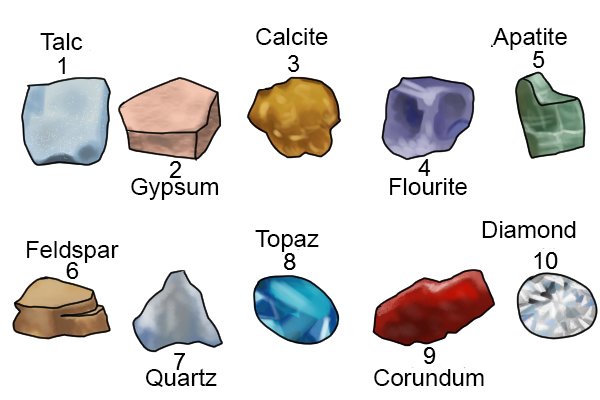Rocks
Earth is made up of hard matter called rocks. They come in different shapes, colour and size. Rocks are found under the soil, in rivers and seas. They are solid material made up of one or more minerals.
Rocks can be hard ( granite) or soft (chalk)
Some important rocks :
Granite :
Granite is a light-colored igneous rock with grains large enough to be visible with the unaided eye.
It is the most common igneous rock found on the Earth’s surface
Granite is composed mainly of quartz and fedspar with minor amounts of mica and other minerals. This mineral composition usually gives granite a red, pink, gray, or white color with dark mineral grains visible throughout the rock .
It is used for making statues and buildings
Marble :
Marble is a metamorphic rock that forms when limestone is subjected to the heat and pressure of metamorphism.
It is composed primarily of the mineral calcite (CaCO3) and usually contains other minerals, such as clay minerals, micas, quartz , pyrite , iron oxides, and graphite.
Marble occurs in large deposits that can be hundreds of feet thick and geographically extensive. This allows it to be economically mined on a large scale.
Marbles can be bluish, gray, pink, yellow, or black in color.
They are used in monuments, buildings, sculptures etc
Standstone :
Sandstone is a sedimentary rock composed of sand-size grains of mineral, rock, or organic material.
Sandstone is one of the most common types of sedimentary rock and is found in sedimentary basins throughout the world.
It is often mined for use as a construction material or as a raw material used in manufacturing.
It is yellow or red in colour
Coal:
Coal is an organic sedimentary rock that forms from the accumulation and preservation of plant materials, usually in a swamp environment.
It is a combustible rock and, along with oil and natural gas , it is one of the three most important fossil fuels.
Slate:
Slate is a fine-grained, foliated metamorphic rock that is created by the alteration of mudstone by low-grade regional metamorphism.
It is blackish in colour and used to make blackboards.
Minerals
A mineral is a naturally occurring chemical compound, having a characteristic crystalline structure, color, and hardness.
Mohs hardness scale lists the hardness of 10 common minerals. The hardest known substance is Diamond.
Some important minerals :
Talc:
Talc is usually green, white, gray, brown, or colorless. It is a translucent mineral with a pearly luster. It is the softest known mineral and is assigned a hardness of 1 on the Mohs hardness scale.
It can be crushed into a white powder that is widely known as “talcum powder.” This powder has the ability to absorb moisture, absorb oils, absorb odor, serve as a lubricant, and produce an astringent effect with human skin. These properties make talcum powder an important ingredient in many baby powders, foot powders, first aid powders, and a variety of cosmetics.
Diamond:
Diamond is a rare, naturally-occurring mineral composed of carbon.
Diamond is the hardest known natural substance.
It is also chemically resistant and has the highest thermal conductivity of any natural material. These properties make it suitable for use as a cutting tool and for other uses where durability is required.
Diamond also has special optical properties such as a high index of refraction, high dispersion, and high luster. These properties help make diamond the world’s most popular gemstone.
Graphite:
It is a naturally-occurring form of crystalline carbon.
It is extremely soft, cleaves with very light pressure, and has a very low specific gravity. In contrast, it is extremely resistant to heat and nearly inert in contact with almost any other material. These extreme properties give it a wide range of uses in metallurgy and manufacturing.
Quartz :
It is the most abundant mineral found at Earth’s surface, and its unique properties make it one of the most useful natural substances.
It has electrical properties and heat resistance that make it valuable in electronic products.
Its luster, color, and diaphaneity make it useful as a gemstone and also in the making of glass.




